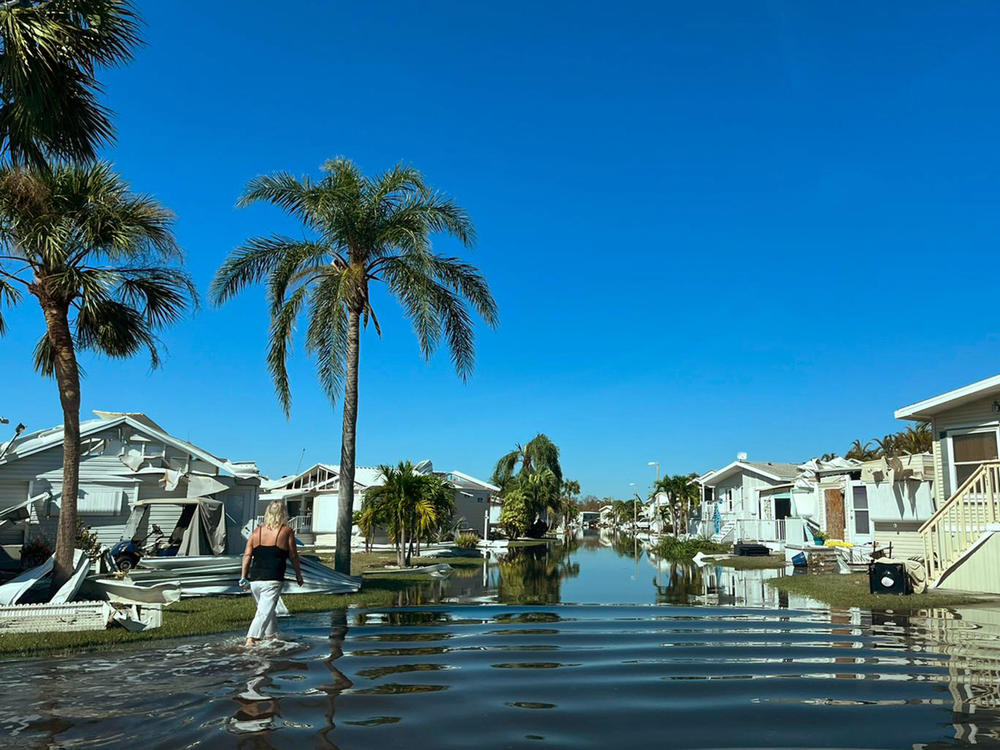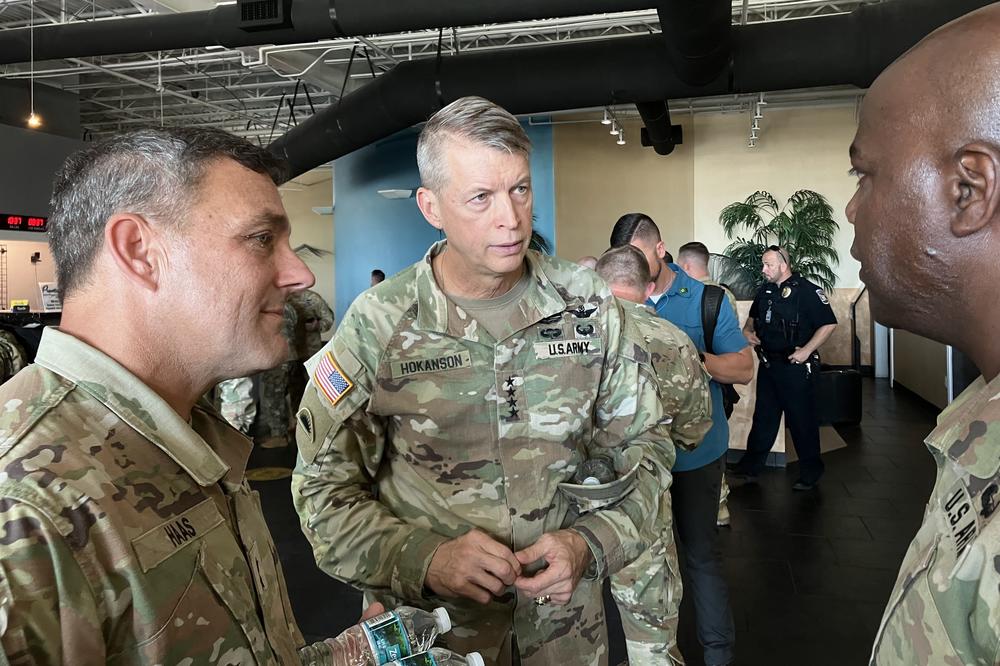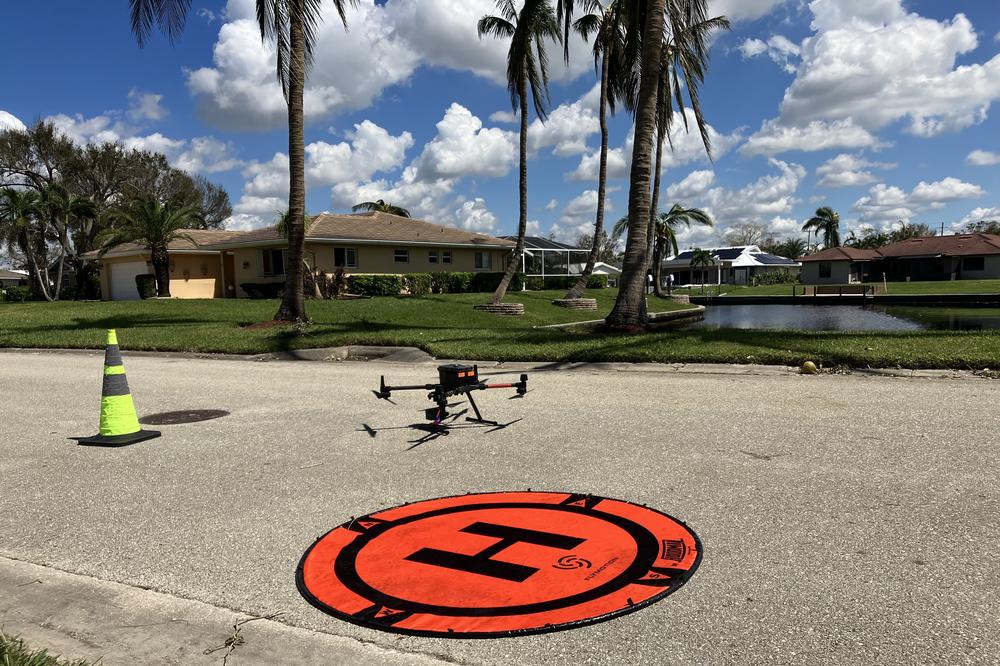Section Branding
Header Content
Flooding and closed roads are some of the challenges Florida's people face after Ian
Primary Content
FORT MYERS, Fla. — A year ago, Francie Pucin moved from Illinois to Florida, eager to enjoy the better weather that the Sunshine State ostensibly has to offer.
Instead, she's experienced the worst weather imaginable.
Hurricane Ian ripped through her mobile home park, Palmetto Palms RV Resort, sending a wall of water coursing through her single-wide.
"My coffee table is on top of my kitchen counter," Pucin says. "It looks like a bomb went off."
She evacuated at the last minute on Wednesday ahead of the storm, as did nearly all her neighbors. Everyone made it through the storm alive in this close-knit community, she says.
Pucin, 55, was an insurance agent in Illinois, but she says like most everyone else at the Palmetto Palms park, she was uninsured.
"It's hard to get insurance on mobile homes down here," she explains. "It's very, very expensive, if you can even get it."
Her home was everything, and without insurance to repair or replace it, she's lost everything, she says.
But she considers herself luckier than many of her neighbors. At least she has a place to go — her snowbird parents, who live in Pompano Beach on the other side of Florida.
For other residents in and around Fort Myers — even those fortunate enough not to have experienced much damage to their homes — fulfilling everyday needs is proving difficult. Power is still out in many areas. While water has been largely restored, there are no guarantees that it's safe to drink, so boil orders remain in place. Lines for gasoline can stretch for hours in many places.
The Army Corps of Engineers has been called to help with the water system, and power has been restored for a little more than half of the customers who lost it after the storm, according to Gov. Ron DeSantis.
Meanwhile, response crews have been aided by good weather, speeding the repair of power lines and clearing of debris.
Federal Emergency Management Agency Administrator Deanne Criswell says that priorities include helping search and rescue missions, and working to restore water and power services in hardest-hit Lee County.
"We're already beginning our planning processes for what the recovery is going to look like," Criswell tells NPR's Weekend Edition. "So while we're still saving lives and stabilizing this incident, we know that we're going to have a long and complex recovery. So we're putting the measures in place right now to make sure we've got the right people on the ground to do that in the days to come."
But as National Weather Service meteorologist Ross Giarratana explains, "even though the heavy rain and bad weather have left the state, all that rain that we did have is continuing to drain through our river system, so we've seen historic rises on many rivers across a good portion of west central and southwest Florida."
Evidence of that comes in a sudden rise on the Myakka River, which caused detours and traffic jams for several hours late Friday and Saturday on a section of I-75, a major artery in southern Florida. By Saturday afternoon, the highway had been reopened.
David Merrick is director of the Florida State University Center for Disaster Risk Policy and coordinates the state's drone reconnaissance. He has teams flying drones over the worst-hit areas, taking video of the damage.
"I guarantee you that people who are without power, without water, maybe without access to their homes, they thought they were fine yesterday or the day before," he says.
But "now it's getting warmer and warmer, and they're thinking, 'maybe I do need to go somewhere else at this point.'"
One of the most isolated areas to get hit by the hurricane is Sanibel Island, linked to the Fort Myers area only by a narrow causeway that was severed by the storm. It took until Friday for rescue crews to begin ferrying people off the island.
Chelle Walton and her husband, Rob, have lived on Sanibel since 1981. They've seen a lot of hurricanes, but by the time Ian shifted toward them last week, it was too late to leave. Lee County officials have been criticized for not ordering evacuation early enough.
As the sea rushed in and began filling up their house, she and her husband made a last phone call to their son, Aaron, with the water up to their chests.
It crested just in time to save the Waltons from drowning. But with no power or cell service, they couldn't call Aaron for three days.
There was nothing for him to do but wait and worry.
"I didn't want to assume the worst," Aaron Walton says. "I was trying to stay positive, and it was rough."
Copyright 2022 NPR. To see more, visit https://www.npr.org.



